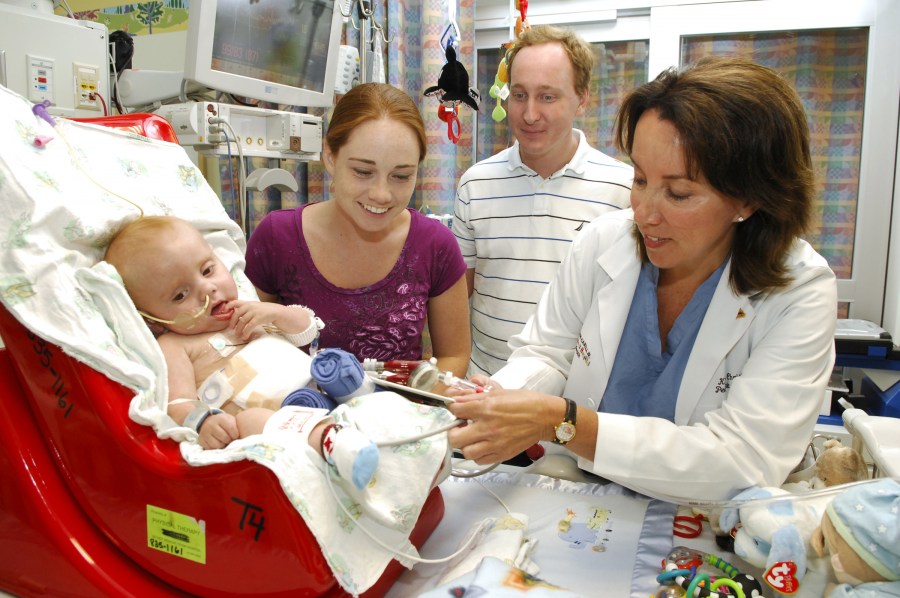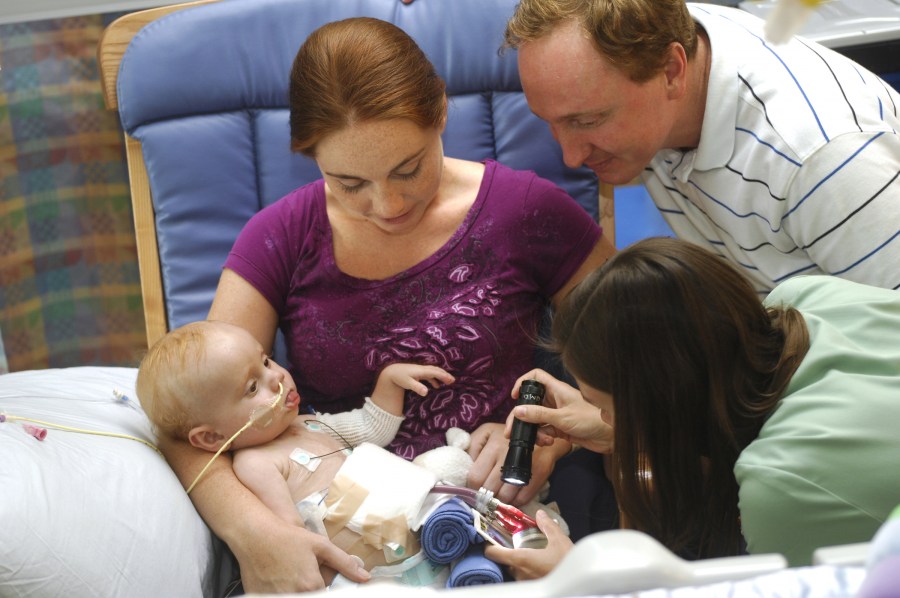
Karla Christian, M.D., right, examines young heart patient Nathan Roberts as his parents, Amanda and James Roberts, look on. (photo by Anne Rayner)
Device serves as baby’s ‘bridge’ to transplant
Several weeks ago, 11-month-old Nathan Roberts was dying from heart failure.
But today the infant has a second chance, thanks to the pediatric heart team at the Monroe Carell Jr. Children's Hospital at Vanderbilt and a ventricular assist device used for the first time in Tennessee.
On May 27, a surgical team with Vanderbilt's Pediatric Heart Institute placed the Berlin Heart device (with the commercial name EXCOR) in Nathan's tiny chest. The device is the first of its kind designed for use in small children or infants, buying them time until a donor heart can be found.
The Berlin Heart is similar to other left ventricular assist devices (LVADS) used in adults, but much smaller.
A plastic tube about a finger-width across attaches to the heart and the major vessels to briefly divert blood out of the body to a pumping chamber that rests outside the patient's body.
The pump then gives the blood a stronger push than the heart can muster to deliver the oxygen and nutrients needed by the brain and vital organs to sustain life.
Although some 200 young patients in the United States have used the device, it is still considered experimental and requires special FDA approval for “compassionate use.”
“His right heart is doing the work it needs to, but there wasn't a way for us to fix the left side of his heart, and a transplant is his only option for long-term health,” said Karla Christian, M.D., the lead pediatric heart surgeon who performed the surgery.

Dana Nichols, R.N., checks the ventricular assist device implanted in infant Nathan Roberts, here with his parents, Amanda and James. (photo by Anne Rayner)
When Nathan was only 4 months old, Christian operated to try to repair his misshapen valves and to close holes between the chambers of his heart. Afterward, he was well enough to return home to Snead, Ala., with his parents and two older sisters. But then he became very ill.
“On the first of May, he came back here to Children's, but by the 12th, he developed bleeding into his lungs. They told us it was because his valve was leaking blood back into his lung circulation,” said James Roberts, Nathan's father.
Nathan was so sick he was placed on ECMO (Extracorporeal Membrane Oxygenation), a system that works much like the bypass pumps used in open heart surgery, for two weeks. James and his wife, Amanda, rarely left his side.
“The trouble with ECMO is that after two weeks, babies are at very high risk of bleeding or a stroke. Because they must be sedated and remain on a ventilator, it is also difficult to keep them strong and healthy enough to make it to transplant,” said Jodi Coombs, R.N., MBA, integrated service line director for the Pediatric Heart Institute.
David Bichell, M.D., the institute's co-director, had been moving forward with plans to bring the Berlin Heart to Vanderbilt even before Nathan became so ill. But then the need became critical.
“We have one of the best ECMO programs in the country, but while ECMO is life saving, the risks soon outweigh the benefits,” he said. “Nathan needed longer-term mechanical support. For young children, the Berlin Heart is the only other option to bridge to transplant.”
The process began after Nathan's first week on ECMO. With the clock ticking, and no donor organ on the horizon, Mary Taylor, M.D., with Pediatric Critical Care, worked with the Institutional Review Board to get emergency approval, while Coombs and others worked to complete the stack of necessary papers and approvals.
Children's Hospital CEO Kevin Churchwell, M.D., and his administrative team made certain all the necessary signatures, supplies and facilities were in place while Department of Pediatrics Chair Jonathan Gitlin, M.D., and Leah Harris, M.D., responded to help the process moved smoothly.
Within a week, representatives of the Berlin Heart company brought the device to Children's Hospital.
They stayed for three days to help with the implantation and to assist the pediatric heart and critical care teams successfully support him through the first critical days of recovery.
The company has reports of children surviving as long as a year with the device, while the average wait to receive a donor heart can be weeks or months. While the company works to prove a clear benefit in use of the device, Coombs says the benefit for Nathan and his family is clear.
Patients can come out from under sedation, ventilators can be removed and children are able to have a much higher functional status than can be mustered on ECMO.
Nathan is now breathing on his own and interacting with his parents and the care team in the PCCU.
“If he were still on ECMO, time would really be running out by now, and he would not even have had a chance to interact with us at all,” James said.
But Nathan's wait is not over. Debra Dodd, M.D., director of pediatric heart transplant, will manage the boy's care in the hopes a donor organ will be soon be found.













